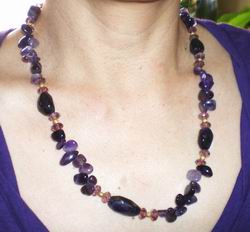
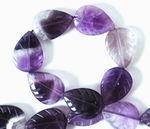
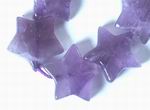

|
|
|
|
|
Everything about Making a Necklace, & Amethyst: February's Gemstone
This monthís theme is designing & making a necklace, plus February's birthstone amethyst.
Scroll down, or click one of the links below on the html version to go to a
certain section. If you have any suggestions for the future, please e-mail me
at
suggestions@mrbead.com.
To go to the
MrBead store click here
For our UK shop in pounds click
MrBead.co.uk
If you
weren't mailed this newsletter enter your e-mail address
here to receive next month's newsletter.
Designer Necklaces Made Easy with Pendants!
How to
Thread Beads & Make a Necklace
Amethyst - The Royal Popestone
15% off
Offer
Designer Necklaces Made Easy with Pendants!
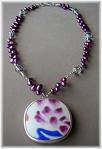
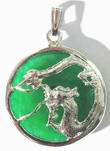
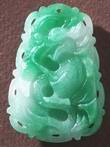

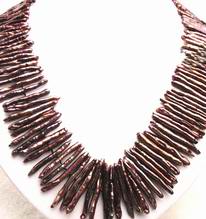
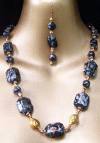
If you don't know how to make center drops with rigid
wires, you should try using pendants as the focal of your necklace. With a
pendant, the stones are set on a bezel, so it looks very clean and professional
and you won't have to worry about wires breaking or coming loose. In addition,
you can string a pendant onto a piece of wire just like a bead. Itís very easy
to make a designer necklace with a pendant.
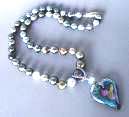
 However, there is one rule to follow to create a
professional-looking necklace. If the pendant you chose has multiple colors, try
to incorporate most of those colors into the rest of the necklace as well. You
can do this using bead of these colors along with colored thread. If you don't
include the major colors into the rest of the necklace, people's eyes will focus
on that particular color and they won't be able to appreciate the effect of the
whole necklace.
However, there is one rule to follow to create a
professional-looking necklace. If the pendant you chose has multiple colors, try
to incorporate most of those colors into the rest of the necklace as well. You
can do this using bead of these colors along with colored thread. If you don't
include the major colors into the rest of the necklace, people's eyes will focus
on that particular color and they won't be able to appreciate the effect of the
whole necklace.
Another way to harmonize the pendant with the necklace is to use beads that are similar in quality as the stones used in the pendant. If the stones in the pendant are high quality gemstones with beautiful facets, use good quality, faceted beads. If the pendant uses tumbled stones with lots of inclusions, you should use baroque beads that won't take the limelight away from the focal pendant.
 Use metal beads and findings for professionalism and to
enhance the focal beads without drawing too much attention to themselves.
Spacers are also useful to add-design and to economize on the beads used. They
vary greatly in size, thickness, and shape so you can dramatically alter the
style of your necklace. Spacers are excellent for adding just a sliver of
metallic flash. Try using small 925 gothic spacers in between colorful single
beads for a classy effect, and cone or dome-shaped ones called bead caps are
great for topping off a drop.
Use metal beads and findings for professionalism and to
enhance the focal beads without drawing too much attention to themselves.
Spacers are also useful to add-design and to economize on the beads used. They
vary greatly in size, thickness, and shape so you can dramatically alter the
style of your necklace. Spacers are excellent for adding just a sliver of
metallic flash. Try using small 925 gothic spacers in between colorful single
beads for a classy effect, and cone or dome-shaped ones called bead caps are
great for topping off a drop.
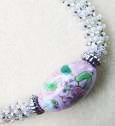

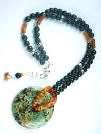 Large beads can also be used as the focal point of your
necklace instead of a pendant Ė frame beads being ideal for this. Plus,
use different sizes and color beads in your necklace for effect. Variation
adds style. Finally, choose the catch to match and remember jump rings to
attach it. A dainty necklace uses a tiny clasp, whereas a heavy necklace
needs a larger, stronger catch.
to top
Large beads can also be used as the focal point of your
necklace instead of a pendant Ė frame beads being ideal for this. Plus,
use different sizes and color beads in your necklace for effect. Variation
adds style. Finally, choose the catch to match and remember jump rings to
attach it. A dainty necklace uses a tiny clasp, whereas a heavy necklace
needs a larger, stronger catch.
to top
See our new Pendant Category
here
Clasps Spacers & Findings
here
How to Thread Beads and Make a
Necklace
Threading beads is easy, but it does help to know a few tricks if you
are going to add a clasp or if you are planning on knotting between each bead
for a necklace. Minimum materials needed: Beads, Beading Thread, Beading Needle, Super Glue &
Stretchy Elastic for Bracelets. Other things to consider: Bead Measure, Beading Tray, Chain
Nose Pliers, Clasp and Bead Tips & Bees Wax for Thread.
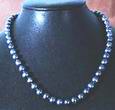
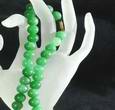
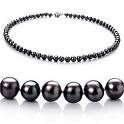
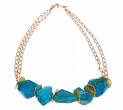 The best way to design a necklace is to work with a beading
tray. You can set up all your beads on the tray and move them around to come up
with the best design. If you don't have a beading tray, use a towel. That way
they won't roll off the table Ė beads have a habit of finding the floor! If you
want a clasp in your necklace, arrange the pattern so that it will take the
place of a bead that is in the center of a group of beads - and consider where
the clasp will go when designing. Fishhook clasps are the most common, but a
round push-in box-type looks best. If your necklace will be 26 inches or
longer, you donít need a clasp. To help plan the design of your necklace
use a beading board, for detail about this click
here.
The best way to design a necklace is to work with a beading
tray. You can set up all your beads on the tray and move them around to come up
with the best design. If you don't have a beading tray, use a towel. That way
they won't roll off the table Ė beads have a habit of finding the floor! If you
want a clasp in your necklace, arrange the pattern so that it will take the
place of a bead that is in the center of a group of beads - and consider where
the clasp will go when designing. Fishhook clasps are the most common, but a
round push-in box-type looks best. If your necklace will be 26 inches or
longer, you donít need a clasp. To help plan the design of your necklace
use a beading board, for detail about this click
here.
 Itís attractive to mix different sizes of beads in a
necklace, and sometimes varying types of beads too. One beautiful large bead
looks nice as a focal point. However, this will affect the weight of thread you
use, since different types of beads have different hole sizes. You need thread
that is thin enough to allow the beads through Ė but also heavy enough to form a
knot that the bead canít slip over. Try different cords and if necessary double
to ensure you get a big enough knot. Silk is the best cord for pearls and
gemstones, giving the necklace a more graceful drop. Nylon like fishing line is
best for glass bead necklaces - cheaper and stronger than silk, but slightly
harder to work. If you plan on knotting between the beads, then choose the
color of the cord carefully.
Itís attractive to mix different sizes of beads in a
necklace, and sometimes varying types of beads too. One beautiful large bead
looks nice as a focal point. However, this will affect the weight of thread you
use, since different types of beads have different hole sizes. You need thread
that is thin enough to allow the beads through Ė but also heavy enough to form a
knot that the bead canít slip over. Try different cords and if necessary double
to ensure you get a big enough knot. Silk is the best cord for pearls and
gemstones, giving the necklace a more graceful drop. Nylon like fishing line is
best for glass bead necklaces - cheaper and stronger than silk, but slightly
harder to work. If you plan on knotting between the beads, then choose the
color of the cord carefully.

 Once your beads are arranged and the thread cut to about
6-inches longer than you plan the necklace (or twice as long if you intend to
knot), you are ready to string. Itís best to use a beading needle. Twisted
wire needles are best as they have a loop at the end that threads easily and
then flattens out to fit through the beads. They are available in different
sizes. For pearls you will need a finer needle, but for most projects a medium
size is ideal. If you want to use a clasp, then string a bead tip first,
but the clasp itself goes on last. The bead tip size depends on your thread,
but a 3.5mm tip fits most. First attach one end of your cord to the bead tip
with a knot, crimp the tip closed, and cut the excess cord away with pliers.
Once your beads are arranged and the thread cut to about
6-inches longer than you plan the necklace (or twice as long if you intend to
knot), you are ready to string. Itís best to use a beading needle. Twisted
wire needles are best as they have a loop at the end that threads easily and
then flattens out to fit through the beads. They are available in different
sizes. For pearls you will need a finer needle, but for most projects a medium
size is ideal. If you want to use a clasp, then string a bead tip first,
but the clasp itself goes on last. The bead tip size depends on your thread,
but a 3.5mm tip fits most. First attach one end of your cord to the bead tip
with a knot, crimp the tip closed, and cut the excess cord away with pliers.
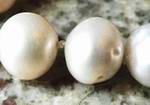 To knot or not to knot is up to you. Knotting makes the
necklace drape nicely and it stops the beads from rubbing against each other or
getting lost if the necklace breaks. Knots also add to the length of your
necklace, so you need less beads. Start your necklace with the right length of
doubled thread and tie a knot at the end. Then you can begin to string your
beads. The first bead that you string must have a hole that is wide enough to
allow you to string the thread through it twice. This is because when you finish
the necklace you will be pulling the thread back through this first bead.
to top
To knot or not to knot is up to you. Knotting makes the
necklace drape nicely and it stops the beads from rubbing against each other or
getting lost if the necklace breaks. Knots also add to the length of your
necklace, so you need less beads. Start your necklace with the right length of
doubled thread and tie a knot at the end. Then you can begin to string your
beads. The first bead that you string must have a hole that is wide enough to
allow you to string the thread through it twice. This is because when you finish
the necklace you will be pulling the thread back through this first bead.
to top
Amethyst:
The Royal Purple Pope Stone
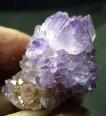
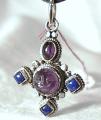
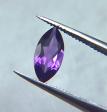
Amethyst is the Birthstone for February, the purple variety of quartz. If it was
not so widespread, amethyst would be very expensive. Its name comes from the
Greek, meaning "not drunken". Perhaps due to a belief that amethyst would sober
the effects of alcohol, or maybe referring to its wine-like color. Although
amethyst is always purple, it comes in shades of pale lilac to deep purple.
Deeper colors are more valuable, ďmilkyĒ amethyst is the cheapest.
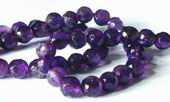
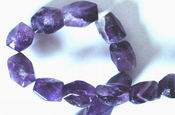
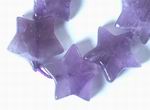
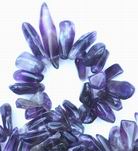
According to Greek mythology, Dionysius, the god of intoxication, was angered by
an insult from a mere mortal and swore revenge on the next mortal that crossed
his path, creating fierce tigers to carry out his wish. Along came unsuspecting
Amethyst, a beautiful young maiden on her way to pay tribute to the goddess
Diana. Diana turned Amethyst into a stature of pure crystalline quartz to
protect her from the brutal claws. Dionysus wept tears of wine in remorse for
his action at the sight of the beautiful statue. The god's tears stained the
quartz purple, creating the gem we know today.
Purple has long been considered a royal color, featured in the British Crown
Jewels and a favorite of Catherine the Great and Egyptian royalty. Leonardo Da
Vinci wrote that amethyst could dissipate evil thoughts and quicken the
intelligence. Because amethyst was believed to encourage celibacy and symbolize
piety, it was very important in the ornamentation of Catholic and other churches
in the Middle Ages. Amethyst is still the stone of bishops who often wear
amethyst rings. Even in Tibet, amethyst is considered to be sacred to the
Buddha.

 Healers and New Agers believe certain gemstones heal on a metaphysical level,
because of the earth's energy that has been absorbed by these stones. Amethyst
is considered to have healing powers of purifying and pacifying - with the
ability to transform lower energies into higher, healing at all levels of mind,
body and spirit. Amethystís sobering and calming qualities associate it with
peace. It is known to calm those with constant rigorous mental activity. Called
"nature's tranquilizer", because it also relaxes the whole nervous system.
Amethyst reduces negativity and brings mental strength, stability, and vigor.
Plus understanding to all that is transitional, especially death and rebirth,
providing peace of mind when a loved one is lost. As an elixir, amethyst can
help toothache, bone and joint discomforts and problems with the stomach and
digestive tract. It has also been known to treat various types of blood disease
and balancing blood sugar.
Healers and New Agers believe certain gemstones heal on a metaphysical level,
because of the earth's energy that has been absorbed by these stones. Amethyst
is considered to have healing powers of purifying and pacifying - with the
ability to transform lower energies into higher, healing at all levels of mind,
body and spirit. Amethystís sobering and calming qualities associate it with
peace. It is known to calm those with constant rigorous mental activity. Called
"nature's tranquilizer", because it also relaxes the whole nervous system.
Amethyst reduces negativity and brings mental strength, stability, and vigor.
Plus understanding to all that is transitional, especially death and rebirth,
providing peace of mind when a loved one is lost. As an elixir, amethyst can
help toothache, bone and joint discomforts and problems with the stomach and
digestive tract. It has also been known to treat various types of blood disease
and balancing blood sugar.
In yoga, amethyst aids the 6th Chakra, the Third Eye, center of the bodyís
spiritual power. Because amethyst heightens awareness, both spiritual and
psychic - increasing intuition and psychic development and transition from a
normal state of consciousness to a deeper awareness.
Amethyst is mined in South American and African countries. African is the best,
but mined in smaller sizes. Very dark amethyst, mostly in small sizes, is also
mined in Australia.
to top
To go to all or amethyst beads click here
Special 15% Offer !
Sample our beads with 15% off any order from our MrBead.com or
MrBead.co.uk bead store, just key in "amethyst" at the checkout (without the
inverted commas) and click "Redeem Coupon".
Offer valid until Thursday 31st January 08 only - so act now! Only for use in our store at the checkout and not valid with any other offers.
To go to our MrBead store click
http://www.mrbead.com
Or UK shop in pounds MrBead.co.uk
To Top of Page
To return to the top of this page click here